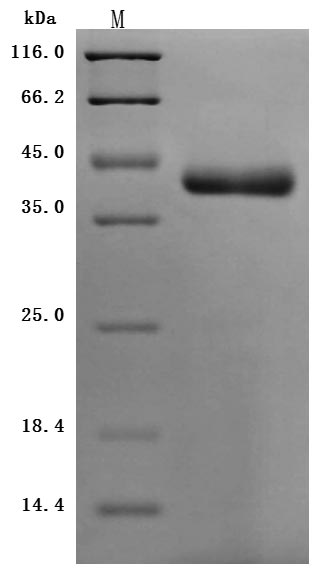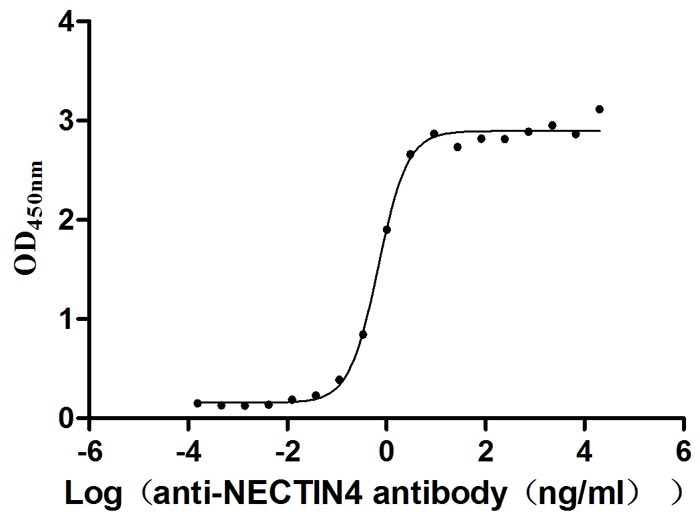Co-introduction of the gene encoding the human Nectin-4 (NECTIN4) protein (32-349aa) with the C-terminal 10xHis-tag gene creates a recombinant plasmid, which is then transformed into mammalian cells. Mammalian cells that can endure a specific antibiotic are selected and cultured under conditions that encourage the expression of the gene of interest. Following expression, affinity purification is employed to isolate and purify the recombinant human NECTIN4 protein from the cell lysate. Its purity exceeds 95% and its endotoxin content is less than 1.0 EU/ug. Its activity has been validated through a functional ELISA.
Nectin-4 is a sticky molecule crucial for many cell activities. It's got several parts: a front end with three immunoglobulin-like pieces, a middle part that spans the cell membrane, and a tail that reaches into the cell's interior and hooks up with the cell's structural scaffold, called the actin cytoskeleton [1]. Belonging to the nectin family, it's involved in steering cells in the right direction, controlling how fast they grow, what they turn into, how they move, and whether they invade other tissues [2]. It teams up with a protein called afadin, which latches onto the cell's internal skeleton, to get its job done [3].
Nectin-4 mostly hangs out on tumor cells, which makes it a promising target for cancer treatments that harness the immune system [4]. It's especially abundant in urothelial carcinoma, suggesting it could be a bull's-eye for drugs in this type of cancer [5]. In some types of thyroid cancer, it's been tagged as a gene that helps tumors grow and spread [6]. It's even involved in the growth of new blood vessels, a process called angiogenesis, via a signaling pathway involving Src, making it a potential target in cancers like angiosarcoma [2]. And it's not just cancers - it's also a doorway for viruses like measles to invade cells [7][8][9][10][11]. Plus, it might have a role in a serious pregnancy complication called pre-eclampsia, and it's found in the skin, esophagus, bladder, and placenta tissues [12]. Lastly, it has been linked to the spread of cancer to other parts of the body and putting the brakes on the immune system in ovarian cancer [13].
References:
[1] R. Rotunno, A. Diociaiuti, M. Dentici, M. Rinelli, M. Callea, C. Retrosiet al., Ectodermal dysplasia-syndactyly syndrome with toe-only minimal syndactyly due to a novel mutation in nectin4: a case report and literature review, Genes, vol. 12, no. 5, p. 748, 2021. https://doi.org/10.3390/genes12050748
[2] Y. Tanaka, M. Murata, K. Tanegashima, Y. Oda, & T. Ito, Nectin cell adhesion molecule 4 regulates angiogenesis through src signaling and serves as a novel therapeutic target in angiosarcoma, Scientific Reports, vol. 12, no. 1, 2022. https://doi.org/10.1038/s41598-022-07727-x
[3] N. Reymond, S. Fabre, E. Lecocq, J. Adélaı̈de, P. Dubreuil, & M. Lopez, Nectin4/prr4, a new afadin-associated member of the nectin family that trans-interacts with nectin1/prr1 through v domain interaction, Journal of Biological Chemistry, vol. 276, no. 46, p. 43205-43215, 2001. https://doi.org/10.1074/jbc.m103810200
[4] A. Reches, Y. Ophir, N. Stein, I. Kol, B. Isaacson, Y. Charpak-Amikamet al., Nectin4 is a novel tigit ligand which combines checkpoint inhibition and tumor specificity, Journal for Immunotherapy of Cancer, vol. 8, no. 1, p. e000266, 2020. https://doi.org/10.1136/jitc-2019-000266
[5] C. Chu, M. Sjöström, E. Egusa, E. Gibb, M. Badura, J. Zhuet al., Heterogeneity in nectin4 expression across molecular subtypes of urothelial cancer mediates sensitivity to enfortumab vedotin, Clinical Cancer Research, vol. 27, no. 18, p. 5123-5130, 2021. https://doi.org/10.1158/1078-0432.ccr-20-4175
[6] J. Chen, A. Bhandari, S. Hirachan, S. Lv, S. Mainali, C. Zhenget al., A specificity protein 1 assists the progression of the papillary thyroid cell
line by initiating nectin4, Endocrine Metabolic & Immune Disorders - Drug Targets, vol. 24, no. 7, p. 789-797, 2024. https://doi.org/10.2174/1871530323666230413134611
[7] M. Mühlebach, M. Mateo, P. Sinn, S. Prüfer, K. Uhlig, V. Léonardet al., Adherens junction protein nectin-4 is the epithelial receptor for measles virus, Nature, vol. 480, no. 7378, p. 530-533, 2011. https://doi.org/10.1038/nature10639
[8] B. Yang, Q. Xue, J. Guo, X. Wang, Y. Zhang, K. Guoet al., Autophagy induction by the pathogen receptor nectin4 and sustained autophagy contribute to peste des petits ruminants virus infectivity, Autophagy, vol. 16, no. 5, p. 842-861, 2019. https://doi.org/10.1080/15548627.2019.1643184
[9] M. Takeda, M. Tahara, N. Nagata, & F. Seki, Wild-type measles virus is intrinsically dual-tropic, Frontiers in Microbiology, vol. 2, 2012. https://doi.org/10.3389/fmicb.2011.00279
[10] N. Otsuki, T. Sekizuka, F. Seki, K. Sakai, T. Kubota, Y. Nakatsuet al., Canine distemper virus with the intact c protein has the potential to replicate in human epithelial cells by using human nectin4 as a receptor, Virology, vol. 435, no. 2, p. 485-492, 2013. https://doi.org/10.1016/j.virol.2012.10.033
[11] Y. Liu, S. Russell, C. Ayala-Breton, S. Russell, & K. Peng, Ablation of nectin4 binding compromises cd46 usage by a hybrid vesicular stomatitis virus/measles virus, Journal of Virology, vol. 88, no. 4, p. 2195-2204, 2014. https://doi.org/10.1128/jvi.02628-13
[12] M. Ito, H. Nishizawa, M. Tsutsumi, A. Kato, Y. Sakabe, Y. Nodaet al., Potential role for nectin-4 in the pathogenesis of pre-eclampsia: a molecular genetic study, BMC Medical Genetics, vol. 19, no. 1, 2018. https://doi.org/10.1186/s12881-018-0681-y
[13] J. Graumann, F. Finkernagel, S. Reinartz, T. Stief, D. Brödje, H. Renzet al., Multi-platform affinity proteomics identify proteins linked to metastasis and immune suppression in ovarian cancer plasma, Frontiers in Oncology, vol. 9, 2019. https://doi.org/10.3389/fonc.2019.01150"








